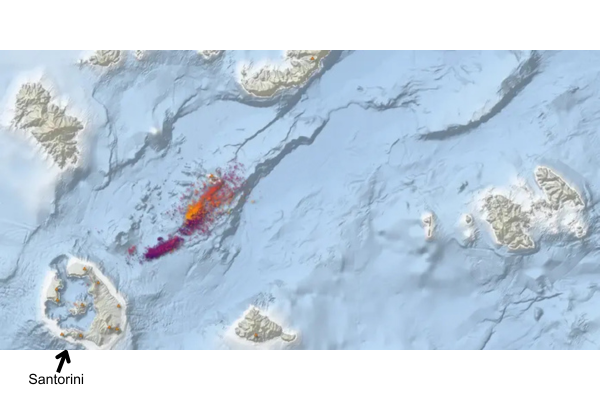The Greek island of Santorini in the Mediterranean has been hit by a series of earthquakes for almost two weeks with around 6400 tremors so far. The strongest quake to date occurred on Wednesday evening (5 February 2025) and reached a magnitude of 5.2 (Alexandridi, 2025). The epicentre of the quakes is located under the Aegean Sea and is slowly moving away from Santorini towards the north (ZDFheute, 2025).
In addition to the earthquakes, slight volcanic activity has been detected on the volcano on which Santorini is located (Alexandridi, 2025). There are also fears that another currently dormant volcano in the region could be awakened by the tremors (ZDFheute, 2025).
Fearing an even stronger earthquake and its possible consequences, around two thirds of Santorini’s 16,000 inhabitants have now left the island. As a result, the police are increasingly monitoring the deserted streets to prevent looting. The Greek Ministry for the Protection of Citizens has deployed additional emergency personnel to the affected islands, including firefighters, rescue teams with search dogs and employees of the energy suppliers, who can operate large generators in the event of a possible power outage (ZDFheute, 2025).
Temporary tents have also been erected to provide shelter and medical care in the event of an emergency. The island’s well-developed emergency plans have so far prevented a major wave of panic. Clear instructions show where safe places are, and warning messages with specific instructions for action are sent to people in the affected regions by text message. In addition, food distributions are prepared and each municipality is asked to report any special needs of residents, such as special dietary requirements or support for people with disabilities during evacuation (Pompl, 2025).
The series of earthquakes also increased the risk of landslides. Currently, five regions on Santorini are considered at risk and require immediate action (Giebel & Brey, 2025). Due to the construction along the crater slope, there is a risk that houses could slide down in the event of continuous moderate earthquakes (ZDFheute, 2025).
The further development of the situation remains uncertain. Various scenarios are possible, but no clear forecast can be made at present (ZDFheute, 2025).
Researchers from the Helmholtz Centre for Geosciences GFZ, an institutional member of the DKKV, are working together with researchers from the GEOMAR Helmholtz Centre for Ocean Research Kiel and Greek partners to install measuring instruments on the seabed and in the Santorini caldera. The aim is to precisely record earthquakes at an early stage and to be able to better assess geological risks (GEOMAR, 2025).
Status: 06.02.2025, 12 pm

Alexandridi, K. (2025, February 6). Santorini-Erdbebenserie: Bislang stärkstes Beben erschüttert Insel. Berliner Zeitung. Retrieved February 6, 2025, from https://www.berliner-zeitung.de/news/santorini-erdbebenserie-bislang-staerkstes-beben-erschuettert-insel-li.2293640.
GEOMAR Helmholtz-Zentrum für Ozeanforschung Kiel [GEOMAR]. (2025, February 4). Beobachtung der Erdbebenaktivität auf Santorini. GEOMAR. Retrieved February 6, 2025, from https://www.geomar.de/news/article/beobachtung-der-erdbebenaktivitaet-auf-santorini.
Giebel, M., & Brey, M. (2025, February 6). Santorini-Erdbeben: Neue Gefahr sorgt für „Warnstufe Rot“ in fünf Gebieten. FrankfurterRundschau. Retrieved February 6, 2025, from https://www.fr.de/panorama/santorini-erdbeben-neues-risiko-sorgt-fuer-warnstufe-rot-in-fuenf-bereichen-zr-93555650.html.
Pompl, M. (2025, February 5). Tausende verlassen griechische Insel Santorini wegen Erdbeben. tagesschau.de. Retrieved February 6, 2025, from https://www.tagesschau.de/ausland/europa/santorini-tausende-verlassen-insel-100.html.
ZDFheute. (2025, February 5). Santorini: Zwei Drittel verlassen Insel wegen Erdbeben. ZDFheute. Retrieved February 6, 2025, from https://www.zdf.de/nachrichten/panorama/santorini-griechenland-erdbeben-flucht-100.html.

(Image source: Marius Isken, GFZ)


